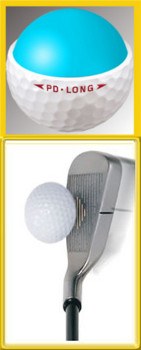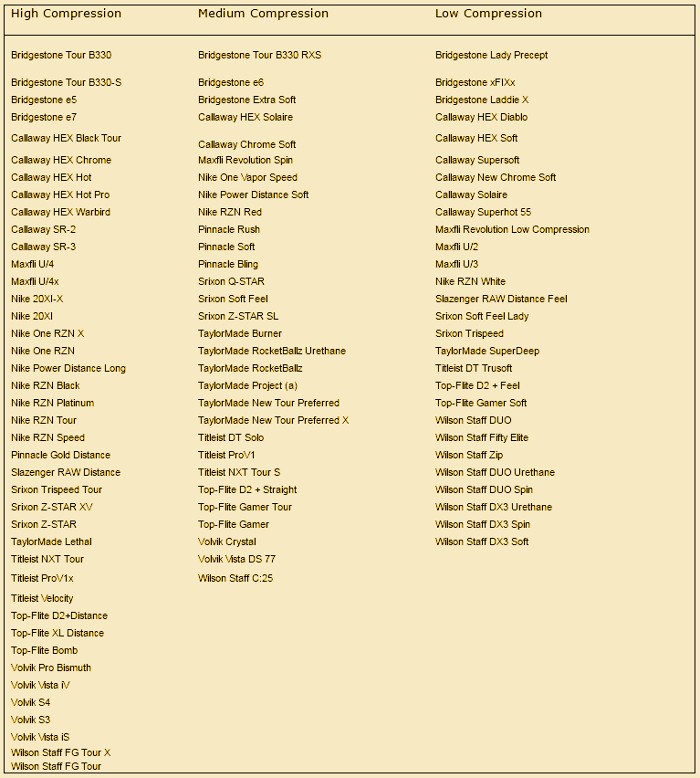 What does golf ball compression really mean? What ball should you be using?
What does golf ball compression really mean? What ball should you be using?
Golf ball manufacturers have made outrageous advancements in golf ball development in just the last 15 years. In years past, the rule of thumb was that better players used high compression golf balls. Nowadays, companies like Bridgestone and Callaway are making low compression golf balls that are being used by all levels of golfers. You can now take advantage of a ball that gives you maximum distance and low spin with your driver, while giving you more spin and feel with your wedges. Titleist is the lone rebel in this area. They maintain that compression has no bearing at all on ball performance. Perhaps Titleist is making this statement with professional players in mind. For me at least, I believe that compression does indeed have an effect on both distance and feel.
Definition
The compression of a golf ball refers to how tightly wound its core threads are. The tighter they are wound, the harder or more compressed the core is. Golf balls come in a variety of compression rates, with the lower number representing lower compression. A ball with a low compression is wound less tight and is considered softer. A ball with a higher compression is wound tighter and is referred to as being harder.
Low Compression
Low compression balls (80 or below rating) travel farther than more tightly wound balls due to their softness and the reaction they have to a swung club (more rebound off the club). Think of a gymnast bouncing on a trampoline or on cement–the soft trampoline provides more rebound and sends the gymnast higher. Due to their softer characteristic, low compression balls will not fly as straight as harder balls, and will be harder to control.
Medium Compression
Medium compression balls have a rating of 90 and provide the best combination of distance and control.
High Compression
High compression balls have a rating of 100 or higher, and are used by the hardest hitters, who may often need the maximal accuracy they provide.
Considerations
Since lower compression balls provide more distance, players with slower swing speeds (generally beginners, juniors, seniors and women) prefer these types of ball. Medium compression balls are preferred by most advanced players who can generate superior (but not necessarily maximal) club speed, and who want optimal control to go with their power or distance. Higher compression balls require a faster swing speed to achieve maximal distance, but provide a truer flight, and are therefore preferred by more power hitters.
In order to get maximum distance from a golf ball, you must compress it fully. It is generally accepted, a fully compressed golf ball is one that is half flattened at impact. To get full distance with any golf ball the golfer must supply enough force to half flatten the ball they are using.
A 70 compression ball should be used by a golfer whose club head speed with their driver is 70 mph, an 80 compression ball should be used by a golfer with an 80 mph club head speed, 90 with 90 and 100 with 100.
In addition, keep in mind that temperature affects golf ball compression. When it is cold outside your 80 compression ball feels and performs more like a 90 compression. Conversely, when it is hot outside, your 100 compression ball will feel and perform like a 90 compression ball.
To determine which golf ball is best for you, consider the following:
- Swing Speed: If you have a slower swing speed (less than 90 mph), consider using a low-compression ball to help generate more distance. If your swing speed is between 90-100 mph, a mid-compression ball may be suitable. For swing speeds above 100 mph, high-compression balls may offer better control and performance.
- Feel Preference: Some golfers prefer the softer feel of low-compression balls, while others may like the firmer feel of high-compression balls. Experiment with different balls to find one that aligns with your feel preference.
- Short Game Performance: Pay attention to how the ball performs around the greens, particularly with chipping and putting. A ball that provides good short game control can lead to lower scores.
- Budget: Consider your budget, as premium golf balls with advanced technology and features may be more expensive.
Ultimately, the best golf ball for you depends on your swing speed, feel preference, and individual game characteristics. Trying out various golf balls and seeking advice from a professional fitter can help you find the ideal ball to enhance your performance on the course.

As you can see, there are many options within each compression classification. You need to identify what your swing speed is, and then commit to a ball in that category.





